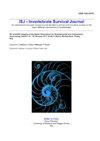Discovery and functional analysis of a new gene (Bm123) in silkworm (Bombyx mori)
IF 1.2
4区 农林科学
Q4 IMMUNOLOGY
引用次数: 0
Abstract
Previously our research group used the microarray analysis and suppression subtractive hybridization technologies to find a Bombyx mori resistance related gene (NCBI ID: NP_001153678.1) to B. mori nucleopolyhedrovirus (BmNPV) and the gene was named Bm123. But there are no more confirmatory studies about Bm123. In this study, BmNPV resistant strain NB, susceptible strain 306, hybrid group 306♀×NB♂ (resistant strain) and NB♀×306♂ (resistant strain) were analyzed by transcriptomic sequencing and Weighted Gene Co-expression Network Work Analysis (WGCNA) to verify the new gene Bm123 function. Correlation analysis between the WGCNA data and phenotype showed that Bm123 is a gene in ME Turquoise module. This module has a strong correlation with disease resistance phenotype (correlation coefficient is 0.753, P value is 0.0047), indicating that Bm123 is a correlated gene with anti-BmNPV. The full length of Bm123 gene was 691 bp, which is not similar with any sequences of other species in NCBI database. But the Bm123 protein contained the transcriptional activator (multiprotein bridge factor 2, MBF2) domain in the 34 to 122 amino acid sequence, closely to Tribolium castaneum by the evolutionary relationship analysis. The BmNPV resistance function, developmental expression pattern and tissue expression pattern of Bm123 were analyzed by using silkworm resistant strain BC10 (screened by eight backcross and two generation of NB and 306 through hybridization and selfing method, each generation is constructed from the feed by adding BmNPV), NB and sensitive strain 306. It was found that after infection with orally BmNPV, the mRNA and protein levels of Bm123 were up-regulated in the midgut of BC10 and NB, and almost not expressed in 306, indicating that Bm123 was a gene associated with resistance to BmNPV. Bm123 protein expression in various tissues of silkworm (fat body, hemolymph, midgut, epidermis, testis, ovary, malpighian tubule and silk gland) was analyzed. It was found that Bm123 was highly expressed in the midgut and malpighian tubule, while the expression in other tissues was lower. Analysis of Bm123 expression in different development stages of silkworm (eggs, 1st to 5th instar larvae, pupae and moth) found that the expression level of Bm123 increased in the 3rd, 4th and 5th instar. The expression level of Bm123 decreased during the pupae and moth stages. It was speculated that the expression of Bm123 was related to the evolution of resistance genes in silkworm. In situ hybridization showed that the Bm123 gene of BC10 was localized in the nucleus of columnar epithelial cells of the midgut, suggesting that Bm123 protein interacts with BmNPV in the silkworm cell nucleus.家蚕新基因Bm123的发现及功能分析
课课组利用微阵列分析和抑制减法杂交技术,发现家蚕对家蚕核多角病毒(BmNPV)的抗性相关基因(NCBI ID: NP_001153678.1),并将其命名为Bm123。但目前还没有更多关于Bm123的确证性研究。本研究通过转录组测序和加权基因共表达网络分析(WGCNA)对BmNPV抗性菌株NB、敏感菌株306、杂交组306♀×NB♂(抗性菌株)和NB♀×306♂(抗性菌株)进行分析,验证新基因Bm123的功能。WGCNA数据与表型的相关分析表明,Bm123是ME绿松石模块的一个基因。该模块与抗病表型相关性强(相关系数为0.753,P值为0.0047),表明Bm123是与抗bmnpv相关的基因。Bm123基因全长691 bp,与NCBI数据库中其他物种的基因序列均不相似。而Bm123蛋白在34 ~ 122个氨基酸序列中含有转录激活因子(multiprotein bridge factor 2, MBF2)结构域,与castaneum的进化关系分析较为接近。以家蚕抗性品系BC10(通过8回交筛选,通过杂交和自交方法筛选NB和306两代,每代均由添加BmNPV的饲料构建)、NB和敏感品系306为材料,分析了BmNPV的抗性功能、发育表达模式和组织表达模式。结果发现,口服BmNPV感染后,BC10和NB的中肠中Bm123 mRNA和蛋白水平均上调,而在306中几乎不表达,表明Bm123是BmNPV耐药相关基因。分析了Bm123蛋白在家蚕各组织(脂肪体、血淋巴、中肠、表皮、睾丸、卵巢、马氏小管和蚕丝腺)中的表达。结果发现,Bm123在中肠和马尔比氏小管中高表达,而在其他组织中表达较低。分析Bm123在家蚕不同发育阶段(卵、1 ~ 5龄幼虫、蛹和蛾)的表达情况发现,Bm123在3、4、5龄表达量增加。Bm123的表达量在蛹期和蛾期呈下降趋势。推测Bm123的表达与家蚕抗性基因的进化有关。原位杂交结果显示,BC10的Bm123基因定位于中肠柱状上皮细胞的细胞核中,表明Bm123蛋白在家蚕细胞核中与BmNPV相互作用。
本文章由计算机程序翻译,如有差异,请以英文原文为准。
求助全文
约1分钟内获得全文
求助全文
来源期刊

ISJ-Invertebrate Survival Journal
IMMUNOLOGY-ZOOLOGY
CiteScore
2.10
自引率
0.00%
发文量
0
审稿时长
>12 weeks
期刊介绍:
Invertebrate Survival Journal (ISJ) is an international and open access journal devoted to prompt and innovative studies on the basic defense mechanisms in invertebrates, in particular with a view to identifying biotechnologies able to act against derived diseases and related economic damage.
Contributions will be mainly in the form of Letters to the Editor, Visions and Perspectives, Short Communications, Technical Reports, Research Reports, Review, Minireview and Reports of Meetings. Letters to the Editor can be commentaries or perspectives on invertebrate defence mechanisms or replies to the data published in ISJ.
 求助内容:
求助内容: 应助结果提醒方式:
应助结果提醒方式:


